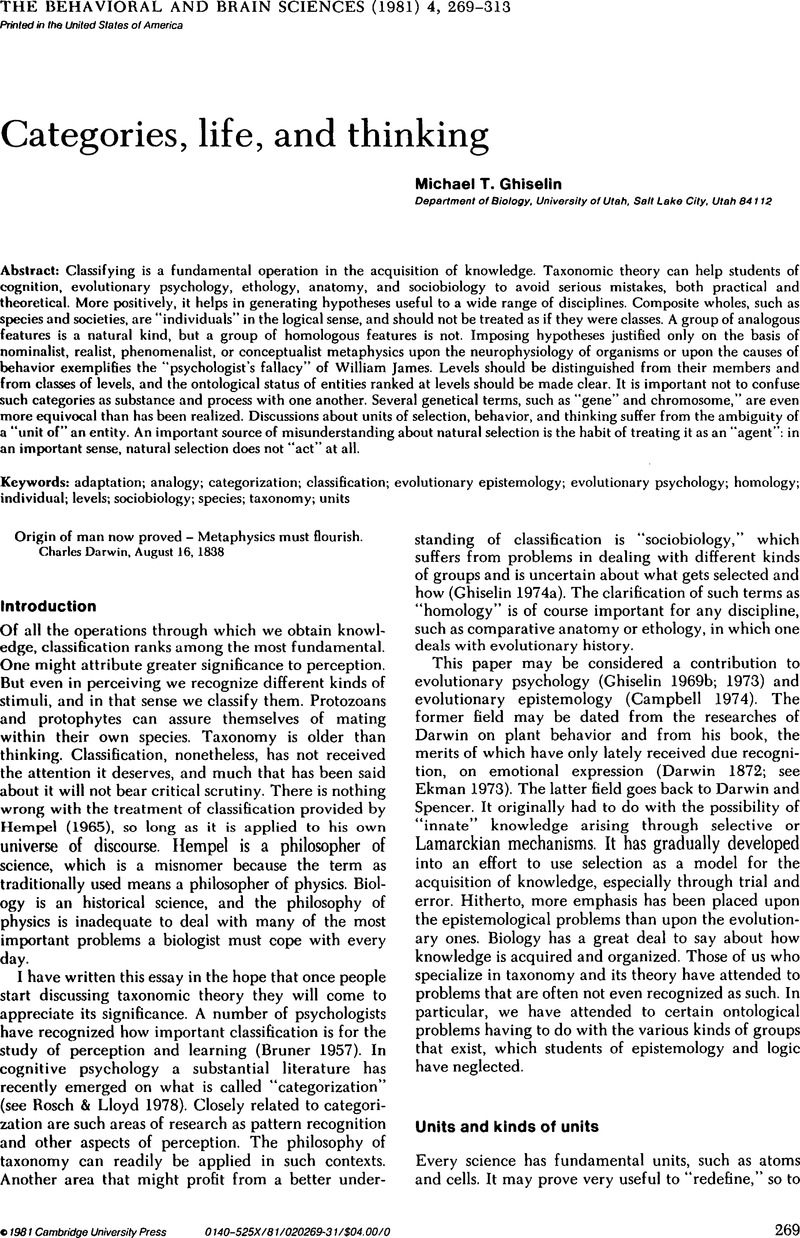Crossref Citations
This article has been cited by the following publications. This list is generated based on data provided by Crossref.
Masters, Roger D.
1982.
Toward a natural science of human culture.
Behavioral and Brain Sciences,
Vol. 5,
Issue. 1,
p.
19.
Rosenberg, Alexander
1982.
Are there culturgens?.
Behavioral and Brain Sciences,
Vol. 5,
Issue. 1,
p.
22.
Ghiselin, Michael T.
1982.
On mechanisms of cultural evolution, and the evolution of language and the common law.
Behavioral and Brain Sciences,
Vol. 5,
Issue. 1,
p.
11.
Hallpike, C. R.
1982.
The “culturgen”: Science or science fiction?.
Behavioral and Brain Sciences,
Vol. 5,
Issue. 1,
p.
12.
Hartl, Daniel L.
1982.
A too simple view of population genetics.
Behavioral and Brain Sciences,
Vol. 5,
Issue. 1,
p.
13.
Wohlwill, Joachim F.
1982.
The place of mind, and the limits of amplification.
Behavioral and Brain Sciences,
Vol. 5,
Issue. 1,
p.
30.
Barash, David P.
1982.
From genes to mind to culture: Biting the bullet at last.
Behavioral and Brain Sciences,
Vol. 5,
Issue. 1,
p.
7.
Fagen, Robert
1982.
Epigenesis and culture.
Behavioral and Brain Sciences,
Vol. 5,
Issue. 1,
p.
10.
Gruber, Howard E.
1982.
Genes for general intellect rather than particular culture.
Behavioral and Brain Sciences,
Vol. 5,
Issue. 1,
p.
11.
Lumsden, Charles J.
and
Wilson, Edward O.
1982.
Précis ofGenes, Mind, and Culture.
Behavioral and Brain Sciences,
Vol. 5,
Issue. 1,
p.
1.
Kovach, Joseph K.
1982.
From genes to culture: The missing links.
Behavioral and Brain Sciences,
Vol. 5,
Issue. 1,
p.
15.
Plutchik, Robert
1982.
Genes, mind, and emotion.
Behavioral and Brain Sciences,
Vol. 5,
Issue. 1,
p.
21.
Shepher, Joseph
1982.
Collaboration between biology and the social sciences: A milestone.
Behavioral and Brain Sciences,
Vol. 5,
Issue. 1,
p.
25.
Caplan, Arthur L.
1982.
Stalking the wild culturgen.
Behavioral and Brain Sciences,
Vol. 5,
Issue. 1,
p.
8.
van den Berghe, Pierre L.
1982.
Resistance to biological self-understanding.
Behavioral and Brain Sciences,
Vol. 5,
Issue. 1,
p.
27.
Schubert, Glendon
1982.
Epigenesis: The newer synthesis?.
Behavioral and Brain Sciences,
Vol. 5,
Issue. 1,
p.
24.
Williams, Thomas Rhys
1982.
Genes, mind, and culture; A turning point.
Behavioral and Brain Sciences,
Vol. 5,
Issue. 1,
p.
29.
Johnston, Timothy D.
1982.
Concepts of development in the mathematics of cultural change.
Behavioral and Brain Sciences,
Vol. 5,
Issue. 1,
p.
14.
Slobodkin, L B.
1982.
A bully pulpit.
Behavioral and Brain Sciences,
Vol. 5,
Issue. 1,
p.
26.
Markl, Hubert
1982.
The power of reduction and the limits of compressibility.
Behavioral and Brain Sciences,
Vol. 5,
Issue. 1,
p.
18.



